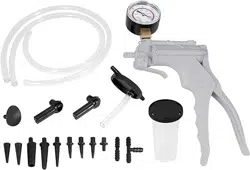Loading ...
Loading ...

INSPECTION, MAINTENANCE AND CLEANING
1. WARNING! Always release the vacuum in the Brake Bleeder/Vacuum Pump before
performing any inspection, maintenance, or cleaning.
2.
Before each use: Inspect the general condition of the Brake Bleeder/Vacuum Pump.
Check for misalignment or binding of moving parts, cracked or broken parts, damaged Hoses,
loose connections, and any other condition that may affect its safe operation. If a problem
occurs, have the problem corrected before further use. Do not use damaged equipment.
3.
When cleaning: Do not clean the Brake Bleeder/Vacuum Pump with cleaners or other
solvents not intended for use with plastic components. Use a clean cloth and, if necessary, a
mild detergent. Do not immerse the Brake Bleeder/Vacuum Pump (1) component in any liquid.
4. When storing: Never store uid in the Reservoir Jar (3) of the Brake Bleeder/Vacuum
Pump. Always dispose of excess uid properly, according to federal, Pump (1) component
in any liquid.
5. WARNING! All maintenance, service, or repairs not listed in this manual are only to be
attempted by a qualied service technician.
Tool service must be performed only by qualied repair personnel. Service or maintenance
performed by unqualied personnel could result in a risk of injury.
When servicing a tool, use only identical replacement parts. Follow instructions in the
“Inspection, Maintenance, And Cleaning” section of this manual. Use of unauthorized parts
or failure to follow maintenance instructions may create a risk of injury.
Item Description
1. Do not force the tool. Use the correct tool for your application. The correct tool will do
the job better and safer at the rate for which it is designed.
2. Store idle tools out of reach of children and other untrained persons. Tools are danger-
ous in the hands of untrained users.
3. Maintain tools with care. Keep tools dry and clean. Properly maintained tools are less
likely to bind and are easier to control. Do not use a damaged tool. Tag damaged tools “Do
not use” until repaired.
4. Check for misalignment or binding of moving parts, breakage of parts, and any other
condition that may affect the tool’s operation. If damaged, have the tool serviced before
using. Many accidents are caused by poorly maintained tools.
5. Use only accessories that are recommended by the manufacturer for your model. Acces-
sories that may be suitable for one tool may become hazardous when used on another tool.
SPECIFIC SAFETY RULES
1. Maintain a safe working environment. Keep the work area well lit. Make sure there is
adequate surrounding workspace. Always keep the work area free of obstructions, grease, oil,
trash, and other debris. Do not use the Brake Bleeder/Vacuum Pump in areas near ammable
chemicals, dusts, and vapors. Do not use this product in a damp or wet location.
2. Maintain labels and nameplates on this product. These carry important information. If
unreadable or missing, contact Performance Tool for a replacement.
3. Keep the Handles of the Brake Bleeder dry, clean, and free from brake uid, oil, and grease.
4.
Prior to using the Brake Bleeder/Vacuum Pump make sure to read and understand all warnings,
safety precautions, and instructions as outlined in the vehicle manufacturer’s instruction manual.
Every vehicle has specic measurement values for vacuum related readings. It is beyond the
scope of this manual to properly describe the correct procedure and test data for each vehicle.
5. WARNING! Carbon monoxide is produced while a vehicle’s engine is operating and is deadly
in a closed environment. Early signs of carbon monoxide poisoning resemble the u, with
headaches, dizziness, or nausea. If you have these signs, the work area may not be vented
properly. Get fresh air immediately.
6. Prior to using the Brake Bleeder/Vacuum Pump, make sure to place the vehicle’s transmission
in “PARK” (if automatic) or “NEUTRAL” (if manual). Then, block the tires with chocks.
7. Be alert for hot engine parts to avoid accidental burns.
8.
Avoid accidental re and/or explosion. Do not smoke near engine fuel and battery components.
9.
Use the Brake Bleeder only with brake uid. Do not attempt to use the tool to siphon any other
liquids. Damage to the internal chamber and seal, or future brake uid contamination may result.
10. Follow guidelines for proper brake uid disposal. Used brake uid should be removed from
the vehicle and properly recycled. Many states require recycling. Contact your local solid/liquid
waste authority for information on recycling. Do not reuse old brake uid.
11.
Brake uid is corrosive. Avoid spilling it on the vehicle’s exterior, it can harm automobile paint.
12.
WARNING! People with pacemakers should consult their physician(s) before using this product
on a running engine. Electromagnetic elds in close proximity to a heart pacemaker could cause
interference or failure of the pacemaker. In addition, people with pacemakers should adhere to the
following: Caution is necessary when near the coil, spark plug cables, or distributor of a running
engine. The engine should always be off if adjustments are to be made to the distributor.
13. WARNING! The brass components of this product contain lead, a chemical known to the
State of California to cause cancer and birth defects (or other reproductive harm). (California
Health & Safety Code § 25249, et seq.)
14. WARNING! The warnings, precautions, and instructions discussed in this manual cannot
cover all possible conditions and situations that may occur. The operator must understand that
common sense and caution are factors which can not be built into this product, but must be
supplied by the operator.
TOOL USE AND CARE
SPECIFIC SAFETY RULES
3
INSPECTION, MAINTENANCE AND CLEANING
6
SERVICE
Loading ...
